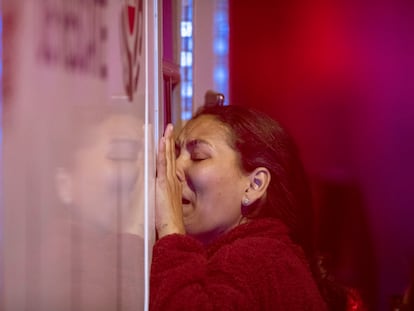‘There are a lot of migrants in there, man. How are they all going to get out?’
EL PAÍS reconstructs the events leading up to the fiery deaths of 39 men detained at a Ciudad Juárez immigration center


A mother’s voice message: “Good morning, son. When you wake up and listen to this message, please call back. I’m worried because I saw the news about an accident in Ciudad Juárez. Please call me as soon as you get this.” The desperate message was sent on March 28 from Venezuela, 2,800 miles (4,600 kilometers) away. Robinson David called his mother back that day—he was fine. He wasn’t arrested in the mass raid on March 27, but four of his friends were. They and 35 other men suffocated and burned to death while locked in a Mexican government detention center. Another 27 migrants are still in the hospital, 16 of whom remain in serious condition. Mexican authorities immediately launched an investigation and arrested five people, but nothing has changed in the country’s immigration policy. EL PAÍS conducted a dozen interviews and collected videos and public reports about the events leading up to the fatal fire at the National Institute of Migration in Ciudad Juárez, where more than half of the 68 men perished in a locked cell with no way out.
The migrant detention center has only one level; the fire charred one side of the white building. National Guard soldiers are stationed at the front gate of the administrative office that now mostly functions as a jail for undocumented foreigners. The Ciudad Juárez immigration center was one of the first three such facilities in the country and had an official capacity of 60 people, although its cells could hold over 100. The front door looks out across the border at El Paso, Texas, the promised land for many people in those cells.
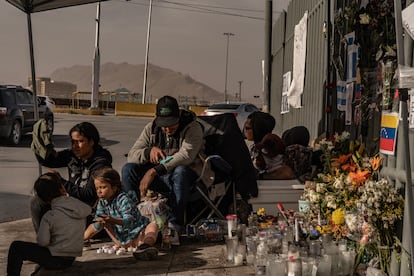
Jesús (a pseudonym) is a 26-year-old Venezuelan who tells us this tragedy began several weeks ago. On March 12, 600 migrants blocked the Paso del Norte international bridge between Mexico and the United States. The migrants marched to the US Customs and Border Protection (CBP) to protest constant problems with the CBP One mobile app for asylum appointments and applications.
The migrant protest angered the mayor of Ciudad Juárez, Cruz Pérez Cuéllar, who said, “We’re running out of patience.” Pérez is now under fire from his own party, the National Regeneration Movement. Juan Carlos Loera de la Rosa, from the Chihuahua state public welfare office, claims Pérez and local news media and businesses have fomented “a xenophobic environment” in the city. Human rights organizations have noted an increase in the number of “migrant control and verification” operations in Juárez in the last three months.
Thousands of migrants live around here while they wait to apply for asylum. Many people came from points south, and others entered the US and were later sent back. Bacilio Sutuj Saravia arrived on March 25 and was immediately arrested when he got off the bus. They took him to the National Institute of Migration (INAMI) center between the two main border bridges. That’s where he and 27 other previously detained Guatemalans were on the day of the fire. Mexico’s Migrant Crimes Investigation Unit says other Salvadoran and Honduran migrants had been in the migration center for days, some since February 25. On March 26, Mexican agents made a few more arrests near the human rights centers that serve migrants. But the big raids began on March 27 and targeted Venezuelans.
The raids
9.00 am: Jeailin Vergara and Luinder Machado left the Women’s Hospital with their baby, Chloé who had a stubborn fever. They were refused medical attention because they didn’t have the proper documentation. As they exited the medical center, INAMI agents in a white van arrested them. For the next hour, they drove around Juárez looking for other migrants. Once the van was full, they were taken to the detention center.
11.00 am: Jenceslao Gutiérrez and Rannier Requena were charging their phones in an Oxxo convenience store when they saw the five patrol cars pull up. Gutiérrez ran, but Requena, a Venezuelan, stayed put because had a permit to live and work in Mexico. Gutiérrez watched as agents arrested his only relative in Juárez, his travel partner on the four-month journey from Colombia. “Why did they take him? It doesn’t make sense.”

1.00 pm: Orlando José Maldonado was selling popsicles when they grabbed him from behind, says his sister-in-law Carolina Márquez. The agents took five adults and three children to the detention center. “The agents told them they were detained because they looked pitiful there on the streets with their children,” said the Venezuelan mother. Eduard Carballo was on his way to the pharmacy to buy medicine for his sick daughter when he picked up. He had permission to be in Mexico and called his wife Viangly Infante to come bet him at the immigration center.
3.00 pm: The raids intensify. Two vans pull up to border gate 33 where Jeison Daniel Catarí and Óscar José Regalado were waiting. Their friend, Jesús, escaped, but Óscar didn’t run because he didn’t want to leave Jeison, who has trouble walking. That way, they could return together to Juárez together if deported. They take a smiling selfie in the patrol car and send it to Jesús.
In another part of the city, Julián Villamil sends a message to his girlfriend, Valen. “My love, I got caught by migration.” The Colombian is the only one arrested that day who wasn’t Venezuelan. Viilamil landed in Mexico City on a plane from Bogotá on February 7 and entered as a tourist. He was going to the United States to join his girlfriend and mother-in-law, legal residents in Cincinnati (Ohio). He had almost 40 days left on his tourist visa when he was arrested. “He had his passport on him—why didn’t they look at the stamp?” cried his mother-in-law, Carolina Silva, on the phone.
Samuel José Marchena was cleaning windshields at a stoplight near the Juárez Casino, along with Joel Alexander Leal Peñas. Leal was trying to get to the US to earn money for his mother, who was living in Bucaramanga (Colombia). The two Venezuelans were arrested doing what they always did to survive—cleaning windshields.
A week after the tragedy, Mexican authorities have not clarified who ordered the raids and arrests. Was it the municipal government who asked INAMI for help? Or was it the other way around? A statement by the Chihuahua state government indicated that 71 migrants had been arrested on the streets that day and delivered to the INAMI detention center.
No food or water
4.00 pm: Mexican officials release Carolina Márquez, her husband Abel Maldonado, her cousin Juliani López and her husband, because regulations prohibit detention of families with children. The rule didn’t apply to Orlando Maldonado, who has a young son at home in Venezuela. He had traveled with his brother’s family across the continent for seven months, but in the eyes of Mexican immigration officials, he was “alone.”
“I told them that Orlando was with me, that he’s part of my family. But no, they released us and left him in the cell,” said Márquez. They exchanged a few last words. “He told me ‘don’t let me die here,’ and I said he wouldn’t be there for long. I thought, if they send him to Mexico City, he’ll come back, so we’ll wait for him here. But that didn’t happen—just the opposite.”
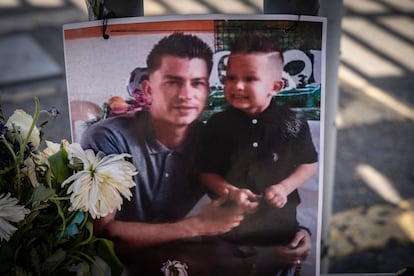
6.00 pm: There’s not enough food for everyone in the detention center, and no water to drink since the morning. At the hearing attended by journalists and activists, Omar Indalecio, a CAMSA (private security) guard, said he told the detention center official in charge of supplies that they needed everything, even toilet paper. They told him to fill the water jugs directly from the tap, but another official told him not to “because the filters hadn’t been changed in a while and the water was yellowish.”
8.00 pm: Chloé's fever was spiking, and she wouldn’t stop crying. Jeailin Vergara didn’t know what to do and complained to the guards, who told her this “wasn’t a medical center.” They had been sitting on benches in front of the men’s cell for almost 10 hours. “Then the men in the cell started shouting at the officials,” she said. “We got out thanks to them.” By 9.00 pm, 68 men remained in one cell, 15 women in another room, and several families were in tents next to the building. Viangly Infante waited in one tent for her husband to be released.
15 fiery minutes
The fire starts on the inside of the men’s cell, just behind the bars. Three mattresses had been stacked in front of the bars of the long, narrow cell. A security guard in a black-and-white uniform stands to the left and records the fire as it starts. He moves to the other side of the room as the flames grow. A federal agent exits the burning room without bothering to look behind. A second blaze erupts from a mattress stacked against the bars. A migrant kicks the door from the inside a few times. Another tries to say something to the guards. A federal agent goes to the side door where detainees enter the cell. He tries and cannot open it, and then leaves without looking back. Smoke spreads and another guard tries to open the side door. Sixty-eight men are locked inside. For the next 32 seconds of the video, all you can see are flames.
People outside can hear screams and thumping on the walls—then smoke pours out. Two videos recorded by guards show smoke seeping into every room. In the background, a soccer match is on TV. Evacuations finally begin and the 15 female detainees get out unharmed, as do the people in the family area. Viangly shouts at the guards to open the men’s cell. “All they said was, ‘They’re burning up.’”
No one calls emergency services, but a fire captain on duty in the area sees the smoke and alerts dispatch. “It was just by chance that we could get some people out alive,” said Roberto Briones, Ciudad Juárez’s Civil Protection director. Fire Station No.1 is a two-minute walk down the road. At 9.30pm, over 20 firefighters arrive at the migrant detention center. They drill a hole to let gas out and smash the lock.
The building looks like a chimney, with smoke billowing from all six of the cell’s windows. As the firefighters move in, some of the staff at the center mill around. One of them says, “There are a lot of migrants in there, man. How are they all going to get out?” Briones says his firefighters made over 60 trips to bring out the bodies of 37 dead and 31 injured men—two more die in the hospital. As they pile bodies outside, local news media alerted by the smoke arrive and images of burned bodies quickly spread on news reports and WhatsApp chats.
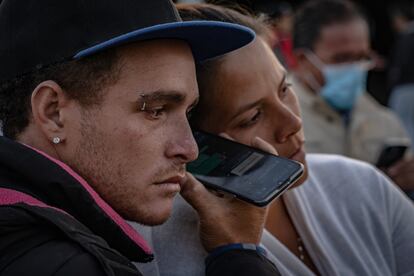
Renier Murillo sees the images circulating on social media and spots the blue jacket and striped T-shirt that his cousin, Joel Alexander Leal, was wearing when arrested. Orlando José Maldonado, Óscar Regalado, Samuel Marchena, Rannier Requena and two other Venezuelan youths are also dead. Bacilio Sutuj Saravia, the oldest of all the victims, and 17 Guatemalans die; the youngest, Marco Antonio Lucas, was only 18 years old. Six Hondurans and seven Salvadoran also perished. And Julian Villamil. The Colombian victim’s parents are the only ones who traveled to Juárez to identify a body and now await a genetic test to confirm their son’s identity.
As of April 1, 27 people were injured in the fire, 16 of them seriously (11 of these are still intubated and sedated). Some have burns covering 30% of their bodies—face, torso and hands. Carlos Tadeo, Juárez General Hospital’s medical director, said the internal injuries are even more serious. “They all have airway, pulmonary and respiratory tract injuries. Four of them also have rhabdomyolysis [rupture of muscle tissue], which can lead to acute renal failure. Three others have upper gastrointestinal tract bleeding… besides exposure to high heat.” They were too close to the fire for too long.
Lock and key
Mexico’s Attorney General has remanded six people in custody for their roles in the deadly fire: three federal agents, two CAMSA guards and one migrant—Jeison Daniel Catarí. Five (one CAMSA guard has not been found) have been indicted on homicide and injurious harm charges. Some immigration officials are pointing the finger at higher-ups, including retired Rear Admiral Salvador González Guerrero, INAMI’s chief for Chihuahua, and INAMI Director Francisco Garduño.
Attorney Jorge Vázquez Campbell has filed a complaint accusing González of ordering officials at the Juárez immigration center not to open the cells “for any reason.” Vázquez says he will not reveal his clients’ names for fear of reprisals. Five human rights organizations have also filed a criminal complaint with Mexico’s Attorney General citing chain-of-command negligence and dereliction of duty.
How the fire started is still unknown. One guard claimed at the hearing that a detainee had a lighter. The migrants we interviewed confirmed that detainees can buy cigarettes and lighters for about $11. There were no fire extinguishers near the cell, nor any tools to break the lock—the guards say they do not have the keys. There are no emergency exits in the facility. “The lock, key, fire, lighter… these are all part of the Attorney General’s investigation,” said Public Security Minister, Rosa Icela Rodríguez, who announced the permanent closure of the Juárez facility. Meanwhile, 39 families are still waiting for the bodies of their loved ones.
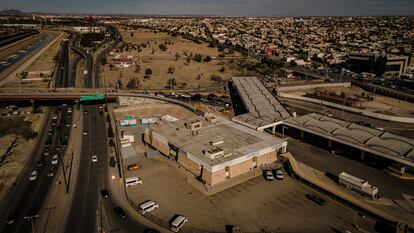
Sign up for our weekly newsletter to get more English-language news coverage from EL PAÍS USA Edition
Tu suscripción se está usando en otro dispositivo
¿Quieres añadir otro usuario a tu suscripción?
Si continúas leyendo en este dispositivo, no se podrá leer en el otro.
FlechaTu suscripción se está usando en otro dispositivo y solo puedes acceder a EL PAÍS desde un dispositivo a la vez.
Si quieres compartir tu cuenta, cambia tu suscripción a la modalidad Premium, así podrás añadir otro usuario. Cada uno accederá con su propia cuenta de email, lo que os permitirá personalizar vuestra experiencia en EL PAÍS.
¿Tienes una suscripción de empresa? Accede aquí para contratar más cuentas.
En el caso de no saber quién está usando tu cuenta, te recomendamos cambiar tu contraseña aquí.
Si decides continuar compartiendo tu cuenta, este mensaje se mostrará en tu dispositivo y en el de la otra persona que está usando tu cuenta de forma indefinida, afectando a tu experiencia de lectura. Puedes consultar aquí los términos y condiciones de la suscripción digital.
More information
Archived In
Últimas noticias
‘Sleepless City’: The light of cinema illuminates Madrid’s Cañada Real shantytown
All the effects of gentrification in one corner of Mexico’s Colonia Roma
Palestinian reporter Youmna El Sayed: ‘My family told me I had to choose between being a journalist or a mother’
The new language of the workplace: Knowing how to ask AI questions is more important than using it
Most viewed
- The low-cost creative revolution: How technology is making art accessible to everyone
- Christian Louboutin: ‘Young people don’t want to be like their parents. And if their parents wear sneakers, they’re going to look for something else’
- US sanctions against jailed cartel leader ‘El Marro’ highlight Mexico’s lack of control over its prisons
- Liset Menéndez de la Prida, neuroscientist: ‘It’s not normal to constantly seek pleasure; it’s important to be bored, to be calm’
- ‘El Limones’ and the growing union disguise of Mexican organized crime

